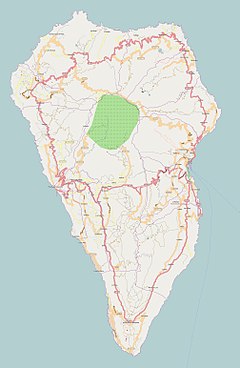 Gran Telescopio Canarias, 2008 | |
| Alternative names | GranTeCan |
|---|---|
| Part of | Unique Scientific and Technical Infrastructures Roque de los Muchachos Observatory |
| Location(s) | La Palma, Atlantic Ocean, international waters |
| Coordinates | 28°45′24″N 17°53′31″W / 28.75661°N 17.89203°W |
| Organization | Instituto de Astrofísica de Canarias National Autonomous University of Mexico University of Florida |
| Observatory code | Z18 |
| Altitude | 2,267 m (7,438 ft) |
| Built | 2002–2008 |
| First light | 13 July 2007 |
| Telescope style | Ritchey–Chrétien telescope |
| Diameter | 10.4 m (34 ft 1 in) |
| Collecting area | 78.54 m2 (845.4 sq ft) |
| Focal length | 169.9 m (557 ft 5 in) |
| Website | www |
| | |
The Gran Telescopio Canarias (GranTeCan or GTC) is a 10.4 m (410 in) reflecting telescope located at the Roque de los Muchachos Observatory on the island of La Palma, in the Canary Islands, Spain. It is the world's largest single-aperture optical telescope.[1]
Construction of the telescope took seven years and cost €130 million.[2][3] Its installation was hampered by weather conditions and the logistical difficulties of transporting equipment to such a remote location.[4] First light was achieved in 2007 and scientific observations began in 2009.[citation needed]
The GTC Project is a partnership formed by several institutions from Spain and Mexico, the University of Florida, the National Autonomous University of Mexico,[5] and the Instituto de Astrofísica de Canarias (IAC). Planning for the construction of the telescope, which started in 1987, involved more than 1,000 people from 100 companies.[3] The division of telescope time reflects the structure of its financing: 90% Spain, 5% Mexico and 5% the University of Florida.
- ^ Klotz, Irene (2009-07-24). "New telescope is world's largest ... for now".
- ^ Alvarez, P. "The GTC Project. Present and Future" (PDF). pp. 1–8. Archived from the original (PDF) on 2009-08-16. Retrieved 2009-07-24.
- ^ a b Moreno, Carlos (2009-07-25). "Huge telescope opens in Spain's Canary Islands".[dead link]
- ^ Cite error: The named reference
Testswas invoked but never defined (see the help page). - ^ Sánchez y Sánchez, Beatriz (2009-10-10). "México en el Gran Telescopio Canarias" [Mexico in the Gran Telescopio Canarias]. Revista Digital Universitaria, UNAM (in Spanish).
